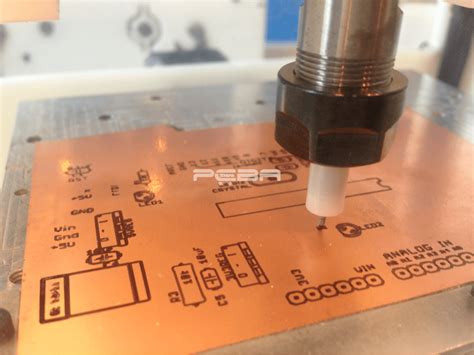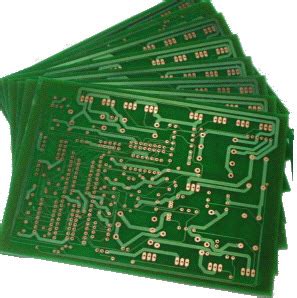Metal core pcb layers
Advantages Of Metal Core PCB Layers In High-Power Applications
Metal core printed circuit boards (PCBs) have emerged as a pivotal technology in high-power applications, offering a range of advantages that make them indispensable in various industries.
One of the primary benefits of metal core PCB layers is their superior thermal management capabilities.
Traditional PCBs, typically made from materials like FR4, often struggle to dissipate heat efficiently, which can lead to overheating and potential failure of electronic components. In contrast, metal core PCBs incorporate a metal layer, usually aluminum or copper, which acts as a heat sink, effectively drawing heat away from critical components and distributing it more evenly across the board. This enhanced thermal conductivity ensures that the PCB operates within safe temperature limits, thereby extending the lifespan of the components and improving overall reliability.
Moreover, the mechanical stability of metal core PCBs is another significant advantage.
High-power applications often subject PCBs to rigorous operating conditions, including mechanical stress and vibration. The metal core provides a robust structural foundation that enhances the board’s durability and resistance to physical damage. This is particularly beneficial in automotive, aerospace, and industrial applications, where reliability and longevity are paramount. The metal core’s rigidity also helps to minimize the risk of warping or bending, which can compromise the integrity of the circuit and lead to malfunctions.
In addition to thermal management and mechanical stability, metal core PCBs offer improved electrical performance.
The metal layer can serve as a ground plane, reducing electromagnetic interference (EMI) and enhancing signal integrity. This is crucial in high-power applications where maintaining signal clarity is essential for optimal performance. The reduced EMI also contributes to the overall electromagnetic compatibility (EMC) of the device, ensuring that it meets stringent regulatory standards and operates harmoniously with other electronic systems.
Furthermore, the use of metal core PCBs can lead to more compact and efficient designs.
The superior heat dissipation properties allow for higher component densities, as the risk of thermal hotspots is significantly reduced. This enables designers to create more compact and lightweight devices without compromising on performance. The ability to integrate more components into a smaller space is particularly advantageous in applications where size and weight are critical factors, such as in portable electronics and advanced lighting systems.
Another noteworthy advantage is the potential for cost savings in the long run.
While the initial cost of metal core PCBs may be higher compared to traditional PCBs, the enhanced durability and reliability can lead to reduced maintenance and replacement costs over time. The extended lifespan of the components and the PCB itself means fewer failures and less downtime, which translates to cost savings for businesses and end-users alike.
In conclusion, the advantages of metal core PCB layers in high-power applications are manifold. Their superior thermal management capabilities, mechanical stability, improved electrical performance, potential for more compact designs, and long-term cost savings make them an ideal choice for a wide range of industries. As technology continues to advance and the demand for high-power applications grows, the adoption of metal core PCBs is likely to become even more widespread, driving innovation and enhancing the performance and reliability of electronic devices.
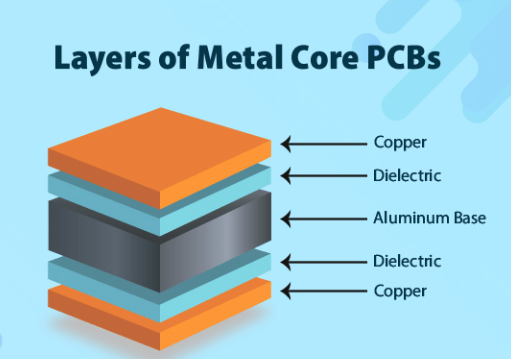
Thermal Management Solutions Using Metal Core PCB Layers
Metal core printed circuit boards (MCPCBs) have emerged as a pivotal solution in the realm of thermal management for electronic devices. These specialized PCBs incorporate a metal core, typically aluminum or copper, which serves as a heat sink to dissipate heat more efficiently than traditional fiberglass-based PCBs. The integration of metal core layers within PCBs addresses the growing demand for effective thermal management in high-power applications, ensuring the longevity and reliability of electronic components.
One of the primary advantages of metal core PCBs is their superior thermal conductivity.
Unlike conventional PCBs, which rely on dielectric materials with relatively low thermal conductivity, MCPCBs utilize a metal core that significantly enhances heat dissipation. This is particularly crucial in applications where electronic components generate substantial amounts of heat, such as in LED lighting, power supplies, and automotive electronics. By efficiently transferring heat away from critical components, metal core PCBs help prevent overheating, thereby reducing the risk of thermal damage and improving overall system performance.
In addition to their thermal management capabilities, metal core PCBs offer mechanical stability and durability.
The metal core provides a robust foundation that enhances the structural integrity of the PCB, making it less susceptible to mechanical stress and deformation. This is especially beneficial in environments subject to vibration or mechanical shock, where traditional PCBs might fail. Consequently, MCPCBs are well-suited for use in industrial and automotive applications, where reliability and durability are paramount.
Furthermore, the design flexibility of metal core PCBs allows for the incorporation of various layers and configurations to meet specific thermal management requirements.
For instance, a single-layer MCPCB consists of a metal base, a dielectric layer, and a copper circuit layer. In contrast, multi-layer MCPCBs can include additional dielectric and copper layers, providing enhanced thermal performance and electrical connectivity. This versatility enables engineers to tailor the PCB design to the unique thermal and electrical demands of their applications, optimizing both performance and efficiency.
Moreover, the use of metal core PCBs can lead to cost savings in the long run.
By effectively managing heat dissipation, MCPCBs can extend the lifespan of electronic components, reducing the frequency of replacements and maintenance. This not only lowers operational costs but also minimizes downtime, which is critical in industrial and commercial settings. Additionally, the improved thermal performance of MCPCBs can enhance the energy efficiency of electronic devices, contributing to lower energy consumption and operational costs.
Despite their numerous advantages, it is essential to consider certain factors when designing and manufacturing metal core PCBs.
The choice of metal core material, for instance, can significantly impact the thermal and mechanical properties of the PCB. Aluminum is commonly used due to its excellent thermal conductivity and cost-effectiveness, while copper offers superior thermal performance but at a higher cost. Additionally, the thickness of the metal core and the dielectric layer must be carefully selected to balance thermal management with electrical insulation and mechanical stability.
In conclusion, metal core PCBs represent a sophisticated solution for thermal management in high-power electronic applications. Their superior thermal conductivity, mechanical stability, and design flexibility make them an ideal choice for industries where efficient heat dissipation is critical. By incorporating metal core layers, engineers can enhance the performance, reliability, and longevity of electronic devices, ultimately leading to cost savings and improved operational efficiency. As technology continues to advance, the adoption of metal core PCBs is likely to grow, driven by the ever-increasing demand for effective thermal management solutions.
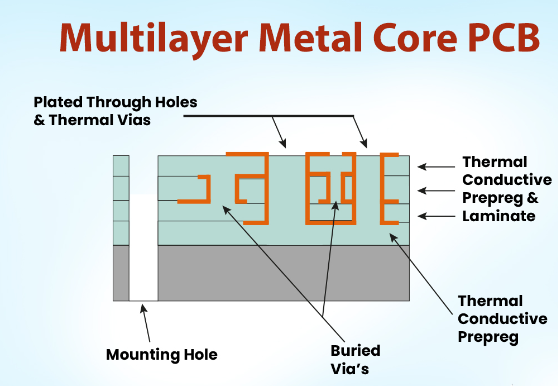
Design Considerations For Metal Core PCB Layers In LED Lighting
When designing metal core printed circuit boards (MCPCBs) for LED lighting applications, several critical considerations must be taken into account to ensure optimal performance and reliability. The unique properties of MCPCBs, particularly their enhanced thermal management capabilities, make them an ideal choice for high-power LED systems. However, the design process involves a careful balance of material selection, layer configuration, and thermal management strategies.
To begin with, the choice of materials is paramount in the design of MCPCBs.
The core material, typically aluminum or copper, plays a crucial role in heat dissipation. Aluminum is often preferred due to its excellent thermal conductivity and cost-effectiveness. Copper, while offering superior thermal performance, is generally more expensive and heavier, which may not be suitable for all applications. The dielectric layer, which insulates the conductive layers from the metal core, must also be carefully selected. It should possess high thermal conductivity to facilitate efficient heat transfer while maintaining electrical insulation properties.
Transitioning to the layer configuration, the structure of an MCPCB typically consists of a metal core, a dielectric layer, and one or more copper conductive layers.
The thickness of each layer must be optimized based on the specific requirements of the LED lighting application. For instance, a thicker metal core can enhance heat dissipation but may also increase the overall weight and cost of the PCB. Conversely, a thinner core may not provide sufficient thermal management, leading to potential overheating and reduced lifespan of the LEDs. The dielectric layer’s thickness and thermal conductivity are equally important, as they directly impact the board’s ability to transfer heat away from the LEDs.
Furthermore, the layout of the conductive layers must be meticulously planned to minimize thermal resistance and ensure efficient current distribution.
The placement of LEDs and other components should be strategically arranged to avoid hotspots and ensure uniform heat distribution. Additionally, the use of thermal vias, which are small holes filled with thermally conductive material, can significantly enhance heat transfer from the top layers to the metal core. These vias should be placed directly beneath high-power components to maximize their effectiveness.
In addition to material selection and layer configuration, thermal management strategies are crucial in the design of MCPCBs for LED lighting.
Effective thermal management not only extends the lifespan of the LEDs but also maintains their luminous efficacy and color stability. One common approach is to incorporate heat sinks or thermal pads into the design. These components help dissipate heat away from the PCB and into the surrounding environment. Another strategy is to use thermal interface materials (TIMs) between the LEDs and the PCB to improve thermal conductivity and reduce thermal resistance.
Moreover, the overall design must consider the operating environment of the LED lighting system.
Factors such as ambient temperature, airflow, and enclosure design can significantly impact the thermal performance of the MCPCB. For instance, in applications where the LED lighting system is enclosed or subjected to high ambient temperatures, additional cooling mechanisms such as fans or liquid cooling may be necessary.
In conclusion, designing metal core PCB layers for LED lighting involves a comprehensive understanding of material properties, layer configuration, and thermal management techniques. By carefully considering these factors, designers can create MCPCBs that not only enhance the performance and reliability of LED lighting systems but also ensure their longevity and efficiency. The intricate balance of these elements underscores the complexity and importance of thoughtful design in the development of advanced LED lighting solutions.
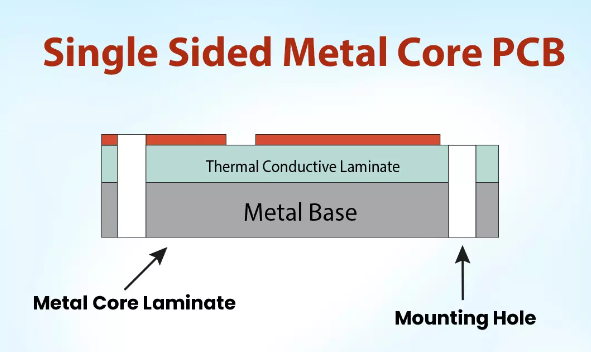
Comparing Metal Core PCB Layers To Traditional PCB Materials
Metal core printed circuit boards (PCBs) have emerged as a significant advancement in the field of electronics, offering distinct advantages over traditional PCB materials. To understand the benefits and applications of metal core PCBs, it is essential to compare them with their conventional counterparts, typically composed of materials like FR4, a composite of woven fiberglass cloth with an epoxy resin binder.
One of the primary differences between metal core PCBs and traditional PCBs lies in their thermal management capabilities.
Metal core PCBs, often constructed with an aluminum or copper core, exhibit superior heat dissipation properties. This is particularly advantageous in high-power applications where excessive heat can lead to component failure or reduced performance. In contrast, traditional PCBs, while adequate for many applications, often require additional thermal management solutions such as heat sinks or cooling fans to maintain optimal operating temperatures.
Furthermore, the mechanical properties of metal core PCBs contribute to their robustness and durability.
The metal core provides a solid foundation that enhances the structural integrity of the PCB, making it less susceptible to mechanical stress and deformation. This is especially beneficial in environments subject to vibration or physical impact. Traditional PCBs, although generally reliable, may not offer the same level of mechanical resilience, potentially leading to issues in demanding applications.
In addition to thermal and mechanical advantages, metal core PCBs also offer improved electrical performance.
The metal core can act as a ground plane, reducing electromagnetic interference (EMI) and enhancing signal integrity. This is particularly important in high-frequency applications where signal integrity is paramount. Traditional PCBs, while capable of incorporating ground planes, may not achieve the same level of EMI reduction without additional design considerations and layers.
However, it is important to note that metal core PCBs are not without their limitations.
One of the primary challenges associated with metal core PCBs is their cost. The materials and manufacturing processes involved in producing metal core PCBs are generally more expensive than those for traditional PCBs. This can be a significant factor for cost-sensitive projects or applications where the benefits of metal core PCBs do not justify the additional expense.
Moreover, the design and fabrication of metal core PCBs can be more complex.
The presence of a metal core necessitates specialized techniques for drilling, routing, and layer alignment. This can result in longer lead times and increased production complexity. Traditional PCBs, on the other hand, benefit from well-established manufacturing processes that are widely understood and readily available, often leading to faster turnaround times and lower production costs.
Despite these challenges, the advantages of metal core PCBs make them an attractive option for specific applications.
Industries such as automotive, aerospace, and LED lighting have increasingly adopted metal core PCBs due to their superior thermal management, mechanical strength, and electrical performance. In these applications, the benefits of enhanced reliability and performance often outweigh the higher costs and manufacturing complexities.
In conclusion, while traditional PCBs remain a versatile and cost-effective solution for many electronic applications, metal core PCBs offer distinct advantages in terms of thermal management, mechanical durability, and electrical performance. The choice between metal core and traditional PCB materials ultimately depends on the specific requirements of the application, including factors such as thermal demands, mechanical stress, and budget constraints. As technology continues to evolve, the role of metal core PCBs is likely to expand, driven by the need for more robust and efficient electronic solutions.




